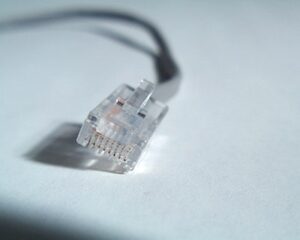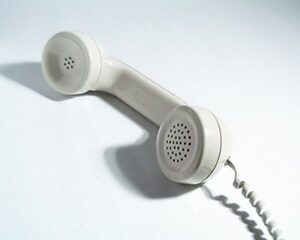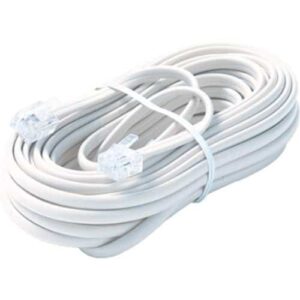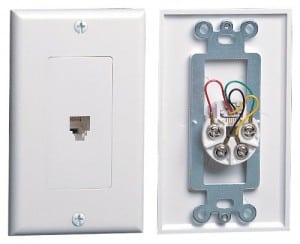Best Way to Route Phone Line Into House
An expert DIY guide for buying and installing telephone lines and jacks, with tips on converting hard-wired jacks, four-prong jacks, modular jacks, and hardwired phones.
Types of Cords
Whether yous are setting up a new phone organisation, adding a line, or simply repairing a line, it is helpful to know the nuts and bolts of telephone wiring.
Line cord. This flat, often grayness cord is the 1 that plugs into a jack at one cease and into a phone at the other. While you should never splice line cords, yous can "two-line" cords together by using a small-scale coupling.
Two-line means basically running a 2nd or separate phone line into a home where in that location already is a connectedness; this is handy for "teen" phones or when creating a abode office with a fax line. It is important to remember that telephones piece of work on very low voltage, so if yous plan on positioning your telephone more than than 25 anxiety from an existing jack, it is meliorate to run a station wire to a closer location and install a new jack there.
Handset cord. The tightly coiled string that connects the handset to the base of a landed phone is called, accordingly, a handset cord. If y'all are replacing 1, be sure to buy the right type for your telephone every bit different phones require unlike handset cords.
Station wire. This multi-conductor wire connects to the network interface jack, where the wires from your phone service provider come into the house. It should never be run outdoors without existence housed in a conduit or, better yet, replaced by a solid-core version made specifically for outdoor use.
Station wire comes in two-pair wire (four conductors), iii-pair wire (six conductors), and four-pair wire (viii conductors). Each wire is insulated with a distinctively colored sheathing. One pair of wires is for telephone service; the others are for backup if the basic-service wires malfunction for whatever reason, for grounding, or for adding more telephone lines in the future.
Wire junctions. The meeting identify for multiple telephone lines, wire junctions come in several options. There is the 42A block, a iv–line wire junction, or you could devise your own by using a standard junction box and wire nuts.
Modular jacks. A phone jack connects the line cord to the station wire. At that place are several options to choose from, including unmarried, double, and combination jacks in affluent-mounted and surface-mounted styles. More on this beneath.
Flush-mounted jacks are commonly used in new construction considering they can be attached directly to wall studs before drywall or other types of wall covering are installed. If you are remodeling, y'all tin can simply insert a special bracket into an opening in a wall and then screw the jack's cover plate to the bracket. The simplest method of all is to affix surface-mounted jacks onto baseboards with brusque screws.
To add another line to a jack, use a dual-outlet adapter; a triplex adapter accommodates ii other lines.
How many jacks practice you need? With our modern-twenty-four hour period need for easily accessible telephones, fax machines, computers, security systems, and satellite amusement systems, it is not uncommon for builders to install 15 to 20 jacks in a new home. At the very least, a home should accept one jack per room and ii or more in those rooms that serve equally entertainment centers, home offices, and the like.
Phone Wiring Basics
When you have familiarized yourself with the bones components of a home telephone organization, yous are ready to develop a routing strategy. Start by mapping out your home'due south floor plan, showing the current locations of all jacks. Then add where you would similar to place new jacks. This will aid you in determining the simplest system to install.
Wiring Telephone Systems
At that place are basically two ways you can wire a telephone organisation, each with its own merits, and so think almost which method will piece of work best for y'all.

Daisy-chain wiring. This method connects several telephone outlets to one excursion. In this arrangement, the wiring begins at a wire junction continued to your telephone service provider's network interface jack and and then runs from jack to jack. A daisy-chain wiring system is hands and quickly installed.
Home-run wiring. This organisation of telephone wiring connects each jack separately to a mutual wire junction. Installation is a little more labor-intensive and requires more hardware than daisy-concatenation wiring, but it has two distinct advantages: Impairment is confined to a single jack and then a trouble is easily identified and fixed, and the system can be easily upgraded as your evolving needs require.
Phone Safety Tips
Though phone lines contain a low level of current, precautions should still be taken when working with information technology.
- Never work on a phone line before deactivating it. It requires a higher level of current to brand a phone ring; should yous go an incoming call while working on the line, it could crusade a nasty shock. Simply removing the handset will avoid such an occurrence. Should your phone accept a lighted dial, look for the source of power, unremarkably a small transformer, and unplug information technology.
- Always hold the insulated part of wires, and, for extra protection, utilise insulated tools.
- Bank check the weather forecast. Lightning can send a hazardous surge down the telephone line.
- If you accept a pacemaker or a defibrillator, call in a pro to work on your telephone wiring.
Planning Wiring Routes
Wiring tin can be extended from jacks or from the junction where wiring enters the home. The rule of thumb is to use the method—or a combination of methods—that results in the shortest run of wire.

Telephone wiring is thin, meaning information technology is easily routable but also easily damaged. Because of this,do non run wires nor install jacks:
• Near whatever source of heat, such as water pipes and air ducts, which can corrode the wiring.
• Within several inches of electric receptacles, which can cause interference on the telephone line.
• In the same conduit or to the same junction box as electric outlet wires because a brusk could cause a surge of current to the phone wire.
• Close to faucets, sinks, swimming pools, tubs, showers, hot tubs, and whatever other source of wet (including clammy basements), where the apply of a phone could constitute an electrocution hazard.
• Too shut to large, grounded appliances in a kitchen.
Methods of Running Wires
There are several options for running new wiring when extending a phone system. The simplest is to just get out it exposed, though this is not only unsightly just also leaves the wiring vulnerable to being damaged. Beneath are some alternatives:
Concealing exposed wiring. To protect the new wiring and brand it equally unnoticeable every bit possible, look at nearby cabinets, closets, shelving, door and window frames, baseboards, and other trim. With the use of phone wire clips or staples, the wire can be secured along any of these features, making it nigh invisible. Better still, if you have rug, simply remove the hardware along the edges, route the wire underneath, and and then re-tack the carpet
Routing wire through walls. If your home's walls are fabricated from drywall (as opposed to lath and plaster), information technology is very easy to drill through a wall to route telephone wires from one room to the next. Find a spot between studs (using an electronic stud finder makes this foolproof) and drill through the wall only above the trim with a 1/four-inch drill bit at to the lowest degree 5 inches long. Inserting the wire into a straw will make feeding the wire through the wall a snap.
Flooring-to-floor wiring. While running phone wire betwixt rooms about always requires cutting a hole in a wall, running a line vertically is actually easier than running it horizontally. You only route the wire through one wall, down below the subflooring, and so back up into a pigsty in the adjoining room's wall.
Installing Modular Phone Jacks
All current telephones are designed for utilize with modular jacks, so, before extending your telephone system, you will have to convert to modular jacks if you don't already have them.

Converting Telephone Jacks
Hard-wired jacks. Telephone connections installed before 1974 are referred to as "hard-wired" considering the telephone could not be unplugged. The and then-called "block" attached directly to the wall or trim, and the "flush-mounted" was actually housed in the wall and covered with a faceplate that was round or rectangular.
Both block and flush-mounted connections are easily inverse. But remove the cover with a screwdriver and replace it with the appropriate modular jack converter.
Four-prong jacks. Portable phones ofttimes used a four-prong jack mounted on a wall or trim, or a flush-mounted jack in a housing box covered by a faceplate. Y'all can either supercede the four-prong jack with a modular ane or use a plug-in adapter that fits the four-prong jack.
Hard-wired phones. Hard-wired desk-bound phones are those with a permanent connection between the line and the phone. To convert these, simply remove the phone housing and install a line cord converter.
Wall phones that are hard-wired cannot exist converted. Instead, you must starting time remove the telephone, which will leave the wires exposed. Practice not let them fall back into the wall because you lot will need them to install a new modular jack.
Installing Modular Phone Jacks
Once you accept your wiring in place, it's time to install new modular jacks. This quick and simple process requires just a screwdriver.
The 3 most common types of modular jacks are flush-mounted jacks, wall-phone jacks and surface-mounted jacks.
Refer to the instructions of the one you have chosen to make sure you properly attach each wire to the correct terminal; wires come up colour-coded to facilitate the installation. Also await for quality jacks with special terminals to accommodate extra wiring, allowing you to route another jack should you demand to in the future.
One time y'all have fabricated the connections, double-cheque to brand sure you have non inserted more than ane conductor in a single slot in the terminal.

Installing a 2d Phone Line
If you are adding just one line, simply call your telephone service provider and ask them to give yous a number for that line. Standard phone wire has 4 conductors; in a habitation with just one phone number, typically but ii wires are used, leaving the other two for a separate line.
Some older homes do not have 4 conductors; if this is your case, you volition demand to add wires to an existing jack or, if necessary, add a new jack.
If you lot want to accept a multiple-line phone, as is common in home function situations, you will need an RJ-xiv jack, meaning it is wired for ii lines, instead of an RJ-11 jack, which is for a single line. If the jack has only i outlet, you lot can plug in an adapter that has multiple outlets.
Calculation Multiple Lines
If you want to add more than i phone line, your phone service provider will have to make the connections at the network interface jack. Should you need a larger interface jack, a service person volition have to come out to install it. One time installed, station wire must exist run to a wire junction, a housing box, or a patch panel, depending on which one you have, and the wires for the new phone lines will extend out from at that place.
Standard station wire has three pairs of conductors, so it tin adjust three extra lines. Category 5 communications cable has iv pairs of wires, which, in addition to handling regular phone connections, can also manage reckoner information transmissions of upwards to 100 megabits per second. Modular jacks and line cord that handles three phone lines are readily bachelor.
Should you want to add more than four phone lines, it may be best to consult with a professional person regarding the placement of station wire, line cord, and jacks.
Extending Your Telephone Organisation
Whether you're calculation one line or several, the steps to extending your phone organization are the aforementioned—tapping into the existing system, routing wire to new jack locations, and installing new jacks.The simplest way to extend a phone system is to route new wire from an existing phone jack or wire junction. Phone jacks and junctions connect wire with ease. You but unscrew the wire junction, insert the conductors into the slots, and tighten the unit, which besides tightens downwardly the conductors.
If in that location isn't a jack or junction where you want to install new wiring, await for a nearby station wire along baseboards and joists, inside closets and cabinets. When you find ane, if you tin find 3 inches of slack in it, yous tin can cutting information technology and attach it to a phone jack or wire junction.
If you lot cannot discover slack in whatsoever station wire, you tin cutting one near your desired location and install two jacks or wire junctions 2 inches apart. The ends of the cut wire tin can be attached, one to each junction, and then a split piece of wire can bridge the short distance between the two.
Source: https://www.hometips.com/how-it-works/telephone-cords-wires-jacks.html#:~:text=Floor%2Dto%2Dfloor%20wiring.,in%20the%20adjoining%20room's%20wall.
0 Response to "Best Way to Route Phone Line Into House"
Post a Comment